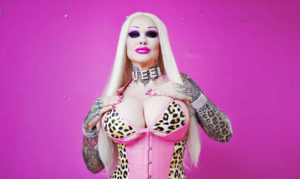The human butt has long been the object of all manner of obsessions. We worry over it: its size, its shape, whether or not it has cellulite on it, how it looks in a pair of jeans. But now, a new source of concern emerges: the alarming possibility that one’s butt — or at least, one’s relationship to butts generally — is racist.
For this we may thank the existence of Butts: A Backstory, a new book by journalist Heather Radke. To be fair, it surely is not Radke’s intention to inculcate racial anxiety in her reader: Butts feels like a passion project, deeply researched and fun to read, offering a deep dive into the history and culture of the human rear end, from the Venus Callipyge (from whose name the word “callipygian” is derived) to Buns of Steel to Sir Mix-A-Lot’s seminal rap celebrating all things gluteal. It is a topic ripe for well-rounded analysis, so to speak. But having been written in the very particular milieu of 2020s America, Butts unfortunately falls victim to the contemporary vogue for viewing all matters of culture through a racial lens. The result is a work that not only flattens the butt, figuratively, but makes the book feel ultimately less like an anthropological study and more like an entry into the crowded genre of works which serve to stoke the white liberal guilt of the NPR tote bag set.
The concept of cultural appropriation has always struck me as both fundamentally misguided and historically illiterate, arising from a studied incuriosity about both the inherent contagiousness of culture and the mimetic nature of human beings. But when it comes to the remixing of thing such as textiles, hairdos or fashion trends across cultures, the appropriation complaints seem at least understandable, if not persuasive: there’s a conscious element there, a choice to take what looked interesting on someone else and adorn your own body in the same way. Here, though, the appropriated item is literally a body part — the size and shape of which we rather notoriously have no control over. And yet Radke employs more or less the same argument to stigmatise the appropriation of butts as is often made about dreadlocks or bindis.
The book is insistent on this front: butts are a black thing, and liking them is a black male thing, and the appreciation of butts by non-black folks represents a moral error: cultural theft or stolen valour or some potent mix of the two. Among the scholars and experts quoted by Radke on this front is one who asserts that the contemporary appreciation of butts by the wider male population is “coming from Black male desire. Straight-up, point-blank. It’s only through Black males and their gaze that white men are starting to take notice”. To paraphrase a popular meme: “Fellas, is it racist to like butts?”
Perhaps needless to say, a wealth of cultural artefacts — from the aforementioned Venus sculpture to the works of Peter Paul Rubens to certain showtunes of the Seventies — belie the notion that white guys were oblivious to the existence of butts until black men made it cool to notice them. But the cultural legacy of the butt is undeniably entangled with the legacy of racism and eugenics, including a sordid and repellent history wherein certain anthropologists of the white male variety both fetishised the physiques of black women with ample backsides and conflated their peculiarities with savagery and promiscuity.
Most prominent in this history is the case of Sarah Baartman, to whom Radke devotes an entire chapter plus countless references: Baartman was a member of the Khoekhoe tribe in South Africa, who in the early 1800s was coerced into travelling to Europe and participating in a freak show-style exhibition in which onlookers gawked at — and sometimes poked or grabbed — her buttocks. If Baartman’s feelings about this remain somewhat mysterious (the records of the time are ambiguous as to how voluntary her participation was), the motivations of the men who trafficked her are less so: anthropologists of the time were obsessed with categorising humans into a racial hierarchy. It wasn’t just Baartman’s butt that fascinated them but her entire body, including the shape of her skull and her elongated labia, which were held up as evidence that she (and hence all black women) were a lower order of human being.
Certainly, it is impossible to do justice to the history of butts without devoting ample space to Baartman. But it’s one thing to give due scrutiny to the fact that some 19th century anthropologists indulged in the repugnant racial stereotyping of black women’s bodies and body parts; it’s another to replicate it ourselves — or to assume that other people are.
Radke does assume, though — repeatedly, persistently, and sometimes in spite of alternative theories or evidence to the contrary. This includes advancing the argument that bustles, the Victorian-era fashion that trended more than 50 years after Sarah Baartman’s death, were inspired by her singular figure — and that white women were coyly, perhaps even consciously, appropriating Baartman’s silhouette in an act of racist fetishisation. Notably, Radke is the first to acknowledge the obvious flaw in her argument: “There is also a question of why a late-19th-century woman would have wanted to look like Sarah Baartman, whose silhouette had been used as the quintessential example of African as subhuman,” she writes. Why, indeed? But Radke answers this question with some crude stereotyping of her own: “White culture and fashion have both proved relentlessly adept at cherry-picking throughout the centuries, finding a way to poach the parts of other people’s culture, histories, and bodies that suit them and leave behind the rest.”
Why would 19th century women have aspired to the silhouette of a sexually promiscuous savage? Because they were a bunch of Karens, that’s why (and here the self-loathing contemporary white woman reader is surely nodding along).
By the time Butts comes around to analysing the contemporary derriere discourse, its conclusions are all but foregone: the political is not just personal, but anatomical. The book calls multiple women, including Jennifer Lopez, Kim Kardashian, and Miley Cyrus, to account for their appropriation of butts, which are understood to belong metaphorically if not literally to black women. The most scathing critique is directed at the then-21-year-old Cyrus, whose twerking at the VMAs is described as “adopting and exploiting a form of dance that had long been popular in poor and working-class Black communities and simultaneously playing into the stereotype of the hypersexual Black woman”. The mainstreaming of butts as a thing to be admired, then, is the ultimate act of Columbusing: “The butt had always been there, even if white people failed to notice for decades.”
There is also the curious wrinkle in Radke’s section on the history of twerking, which credits its popularisation to a male drag queen named Big Freedia. The implicit suggestion is that this movement style is less offensive when performed by a man dressed as a woman than by a white woman with a tiny butt.
Butts doesn’t claim to be a story with a moral, but one nevertheless emerges: everyone may have a butt, but butts are not for everyone. And it is worth noting that however much baggage it assigns the white men who like butts, its implications are even more fraught for the white women to whom the butts are attached. One gets the sense that non-black women are not supposed to have big butts — that those who do have accomplished something unnatural if not outright suspicious. And if you insist on having a butt (and, really, do you have to?), then you must under no circumstances be proud of it, or accept positive attention for it, or — heaven forfend — make it part of your brand.
Ironically, the author of this book is herself a white woman with a large backside, a fact of which she periodically reminds the reader. And yet, Butts thoroughly subsumes its subject matter into the cultural appropriation discourse in a way that implicitly impugns all the non-black women who look — at least from behind — a hell of a lot more like Nicki Minaj than Kate Moss, women who perhaps hoped that their own big butts might be counted among those Sir Mix-a-Lot cannot lie about liking. It is worth noting, too, that the women hung out to dry by this argument are the same ones who other progressive identitarian rhetoric almost invariably fails to account for: the more it indulges in the archetype of the assless willowy white woman, the more Butts excludes from its imagination the poor and working class — whose butts, along with everything else, tend to be bigger. It fails to account, too, for those from ethnic backgrounds where a bigger butt — or, as one of my Jewish great-grandmothers might have said, a nice round tuchus — is the norm.
All told, Butts offers an interesting if somewhat monomaniacal look back at the cultural history of the derriere. But as for how to view our backsides moving forward — especially if you happen to be a woman in possession of a big butt yourself — the book finds itself at something of a loss. Those in search of body positivity will not find it here; Radke is firm on this front, that white women who embrace their big butts are guilty of what Toni Morrison called “playing in the dark”, dabbling thoughtlessly with a culture, an aesthetic, a physique that doesn’t really belong to them. The best these women can hope for, it seems, is to look at their bodies the way Radke does in the final pages, with a sort of resigned acceptance: her butt, she says, is “just a fact”. On the one hand, this is better than explicitly instructing women to feel ashamed of their bodies (although implicitly, one gets the sense that shame is preferable to the confident, twerking alternative). But after some 200 pages of narrative about the political, sexual, cultural, historical baggage with which the butt is laden, it feels a bit empty, a bit like a cop-out. It could even be said — not by me, but by someone — that Butts has a hole in it.
Disclaimer
Some of the posts we share are controversial and we do not necessarily agree with them in the whole extend. Sometimes we agree with the content or part of it but we do not agree with the narration or language. Nevertheless we find them somehow interesting, valuable and/or informative or we share them, because we strongly believe in freedom of speech, free press and journalism. We strongly encourage you to have a critical approach to all the content, do your own research and analysis to build your own opinion.
We would be glad to have your feedback.
Source: UnHerd Read the original article here: https://unherd.com/



